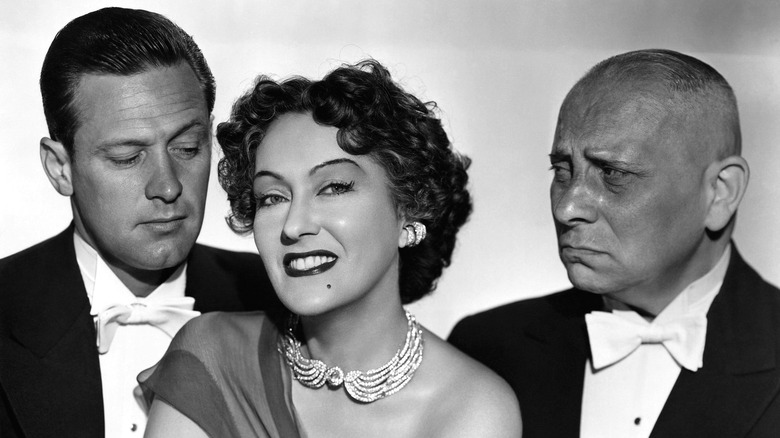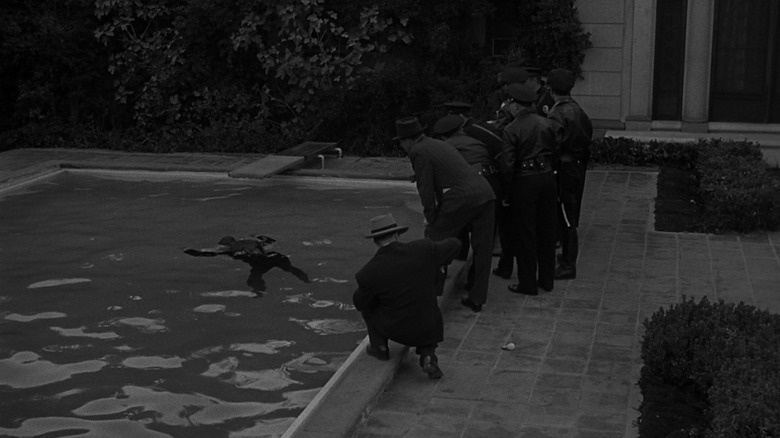Why Sunset Blvd. Had To Scrap Its Original Opening Scene
Billy Wilder always considered himself a writer first and a filmmaker ... well, hardly ever. Indeed, his view of his profession can be handily summed up on his own tombstone, which reads "I'm a writer, but then again, nobody's perfect." While critics, including this author, find Wilder's filmmaking style to be masterfully understated and efficient, Wilder always considered himself to be more of a story man. Wilder wrote dozens of films in German and in English (that were produced; who is to say how many unproduced screenplays he had a hand in) going back to his first writing credit in 1929, and directed about half of his many screenplays himself, developing the sharpest of eyes for the way cinematic stories function. Wilder was pragmatic when it came to the blend of story and cinematic visuals, often claiming the aforementioned efficiency as his only trademark:
"You will not find in my pictures any phony camera moves or fancy setups to prove that I am a moving-picture director. My characters don't rush around for the sake of being busy. I like to believe that movement can be achieved eloquently, elegantly, economically and logically without shooting from a hole in the ground, without hanging the camera from the chandelier and without the camera dolly dancing a polka."
(That "hole in the ground" bit was likely a dig at Orson Welles, and how he required a shot so low for "Citizen Kane," that he literally dug a hole in the ground to fit the camera.)
Wilder's 1950 film "Sunset Boulevard," which he co-wrote with his longtime collaborator, producer Charles Brackett, begins with a dead screenwriter named Joe Gillis (William Holden) floating face-down in a pool, narrating the film from beyond the grave. It is certainly one of the more eye-catching moments of 1950s cinema for its grimness, winking cynicism, and, despite what Wilder thinks about his own filmmaking style, a wicked element of subtle panache. While that moment is often cited in scholarly pieces and essays about "Sunset Boulevard," the original opening that Wilder shot was grimmer still. It was originally set to open in a morgue.
The morgue
In an excellent essay published on Cinephilia & Beyond, it is revealed the idea for the original opening came when Wilder and Brackett were suffering from a mild case of writer's block. They had told Paramount they were writing a film about a silent movie star who returns to Hollywood in triumph, but their screenplay was getting darker by the draft, and the pair ended up working on a story of a dejected screenwriter who encounters a fallen silent movie star who has given over to delusions of a triumphant return when no return is arranged or perhaps even possible. Stuck on their script, the pair ended up hiring their bridge partner D.M. Marchman, Jr. to aid.
It's not a part of the public record which screenwriter first cracked the code to the film's opening scene, but one of them thought that a narration from beyond the grave would have been appropriate to highlight the dark tone of the movie. And what better place to see a dead person than the Hollywood morgue? The trio wrote a scene of Joe Gillis being wheeled on a gurney into a room surrounded by corpses — just another stiff. The idea was that Joe was going to be telling his story not to the audience, but to the other corpses in the room with him. Notable timing: "Tales from the Crypt" would debut the same year "Sunset Boulevard" was released.
The original ending was also different. In the final version, we witness Joe's body being pulled from the swimming pool, waterlogged and very much the worse for wear. In the original version, Joe was to lay back down on the proverbial slab, when Betty (Nancy Olson) enters to weep over him.
It tested poorly
When Paramount tested the morgue-centric version of "Sunset Boulevard" to audiences, they (both Paramount and the audiences) were livid. It seemed that mortuaries were a mite too gruesome for a mainstream crowd, and Wilder had to go about finding a new way to shoot the film in a way Paramount would approve. Wilder eventually came up with a clearer way to communicate the film's cynicism. The finished version begins with police cars pulling up to Norma Desmond's mansion, Joe Gillis' handsome (dead) face, and a general sarcasm about how Hollywood really can kill ya.
The horrible test screenings, however, caused Paramount to shelve the project for a full six months. Eventually, Paramount got over their cold feet, tested the new cut to test audiences, and they (both Paramount and the audiences) found it to be much more acceptable.
The original cut, seen above, was too funereal. Too downbeat. Less visually dynamic. Given what was eventually released, this is a case when it's easy to agree with the studio's decision-making process over the artist's original intent. Personally, I find the morgue opening to be perhaps too cliché; it is reminiscent of any number of scare flick and conservative, classroom-ready propaganda films of the 1930s about the dangers of moving to the big city, the horrors of marijuana, or the risks of driving drunk. I ended up dead, and so! Might! You! My personal issues with the morgue opening do not relate to its grimness, but to how corny it is. Yes, the opening we got was the better one.
"Sunset Boulevard" ended up winning Brackett, Wilder, and Marchman Oscars for Best Story and Screenplay at the 23rd Academy Awards (a now-moribund category). The film, however, lost Best Picture, Director, and Supporting Actor to "All About Eve," and lost several other categories besides. Regardless, its reputation is secure, and it remains one of the best films ever made about Hollywood.
Now 100% morgue-free!

